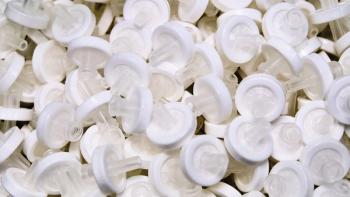
When Does Flow Rate Matter? Criteria for Testing Optimal Filter Flow Rate
br> Sterilizing grade, 0.2-µm rated membrane filters are used in many biopharmaceutical processes to ensure the absence of particles and microorganisms from the filtered fluid (1, 2, 3). These filters must meet particular performance criteria in specifically defined applications. For this reason, during filter design, one performance criterion often is enhanced at the expense of another. Consequently, critical process and flow parameters must be defined appropriately to identify the optimal flow membrane filter for a specific application. This paper describes such an evaluation schematic and tests, as well as some common misconceptions.
Authors:Maik W. Jornitz is group vice president, global product management, bioprocess, Sartorius North America Inc., Edgewood, NY, tel. 631.254.4249, ext. 8309, maik.jornitz@sartorius.com. Theodore H. Meltzer is a principal at Capitola Consultancy, Bethesda, MD.
Sterilizing grade, 0.2-µm rated membrane filters are used in many biopharmaceutical processes to ensure the absence of particles and microorganisms from the filtered fluid (1, 2, 3). These filters must meet particular performance criteria in specifically defined applications. For this reason, during filter design, one performance criterion often is enhanced at the expense of another. Consequently, critical process and flow parameters must be defined appropriately to identify the optimal flow membrane filter for a specific application. This paper describes such an evaluation schematic and tests, as well as some common misconceptions.
When Does Flow Rate Matter?
Flow rate is critical for membranes used to filter solutions such as buffers, which have low contamination levels and few fouling components. The prime objective in such applications is to filter the defined fluid volume as quickly as possible into a transfer vessel or storage bags to minimize operational downtime.
Filter flow rate affects equipment scheduling and thus the capacity available in a production facility. For example, a 0.2-µm rated filter with a low flow rate (2,500 L/h) would require 48 min to filter a 2,000-L volume, whereas a high-flow filter (6,000 L/h) would require only 20 min to filter the same volume. This would reduce the time for equipment use in half. Alternately, the effective filtration area could be reduced in half. Either way, filter costs would be reduced.
Because total throughput is not the focus, filters for filling applications do not contain the protective layers common in throughput-enhanced filter designs (8, 9). Instead, high-flow-rate filters have a specific membrane design and single-layer construction.
Criteria to Consider
To gain optimal flow rates from membrane filters, many criteria can be controlled in the filtration process or design. Examples include:
• Differential pressure
• Effective filtration area
• Filter design or membrane configuration, including porosity, pore structure, and membrane thickness, as well as the diameter of the inner core, adapter, and connector (4, 5).
Differential pressure. One way to increase a filter’s flow rate is to raise the differential pressure over the membrane. Before doing this, however, maximum operating pressures must be considered. If the operating pressures are too high—specifically if the filtration process stops frequently (i.e., in pulsating applications)—the filter membrane can be damaged. Figure 1 shows such damage on the outer pleat-edge of a membrane that had instabilities due to its membrane design and pleatability (8).
Filtration area. Another way to achieve an optimal flow rate is to increase the filtration area. Doing so may increase the cost per liter of filtered volume, however, and increasing the pleat density of a filter often does not achieve the required filter area. For example, it is generally not possible to double the flow rate by increasing the filtration area.
.
Membrane configuration. A membrane’s design determines its porosity, thickness, and pore structure (6). There is limited flexibility in membrane configuration, however. For example, flow rate can be enhanced by altering membrane thickness; the thinner the membrane, the lower the flow resistance and thus, the higher the flow rate. However, membrane thickness affects the filter’s retentivity; a membrane that is too thin might allow organism penetration.
Most flow-enhanced filters are single-membrane designs. Homogenous double-layer designs have a higher total membrane thickness and as a result, the flow rate of such filters is often insufficient (Figure 2) (10).
Process Parameter Considerations
High-flow applications that stop and start (e.g., during filling processes) can create water hammer or pressure pulsation. Therefore, flow-enhanced membrane filters must be mechanically stable to resist such pressure variations and flexing of the filter pleat pack. Filter manufacturers routinely test high-flow filter cartridges to verify that the mechanical resistance defined will be achieved. Such testing is necessary to ensure appropriate functioning in the end user’s process, yet not every filter in the high-flow class achieves such resistivity in practice (Figure 3). For that reason, we recommend performance qualification trials in the actual filtration process.
The membrane configuration is a key element to achieve optimal flow rate conditions. Figure 2 shows that a single-layer membrane configuration will achieve higher flow rates than a membrane double-layer combination, especially of homogenous (e.g., 0.2/0.2 µm) design.
The flow resistivity of a homogenous double-layer filter can be so high that a single-layer membrane filter of a smaller pore size (for instance, a 0.1-µm rated membrane) might reach a comparable flow rate (Figure 4). Furthermore, the support fleece and pleat densities must be well balanced to avoid a too-small effective filtration area or uneven flow distribution in the membrane pleat pack.
Is Testing 47-mm Discs Useful?
Filter flow rate depends on multiple criteria besides differential pressure, pore structure, porosity and thickness. The entire design of the filter and membrane configuration, as well as any connection to the filter element, influences flow rate performance (7). For example, a membrane can have an excellent flow rate, but if it is not appropriately pleatable, the resulting filter cartridge will have a lower effective membrane area, yielding a low flow rate.
It is insufficient to test only the membrane, as is commonly done with 47-mm discs. Such tests will not be able to demonstrate the performance of a filter element used in the production process. We have conducted tests that show that initial flow rate comparison trials with 47-mm discs are meaningless (Figure 5).
The 47-mm filter discs used in a comparison test all have the same theoretical filtration area of 17.4 cm². When these filters are scaled up, however, the effective filtration area of the resulting 10-in. filter cartridges varies widely, from 4,500 to 7,500 cm². Also, the flow rates of these filters at 14.5 psi differential pressure can vary from 2,700 to 8,000 L/h. Testing just the 47-mm discs does not capture these variations; if it did, the results would show that one 47-mm disc filter has a flow rate threefold higher than another 47-mm filter. In addition, the inlet and outlet connectors of the test device might not be able to cope with such flow.
How to Test for Flow
Performance qualification in a large-scale trial, under real processing conditions, is the best way to ensure that the filter chosen withstands the set of process parameters.
Large pleated devices must be used to evaluate and compare the real flow rates of the filters used in production. If the ultimate filter is a capsule device, the flow-rate tests should be conducted with a capsule; similarly, if the filter is a 10-in. filter element, the tests should be conducted in such a setup (7). If multiple filters are compared, water can be used in a side-by-side trial with comparable elements.
Such testing takes into account the entire design of the filter, the membrane design, the effective filtration area, flow distribution resulting from pleat densities, and the fleece thickness. The tests should be performed under the required or specified process conditions: a set inlet pressure should be established so that the time to filter a fixed fluid volume can be measured.
In such testing, it is very important to keep the process parameters constant. If the flow rate tests are performed to size a filter system, the actual fluid should be used, under the process conditions found in the production process. Using the actual fluid also accommodates for specific fluid properties (such as viscosity) that must be checked. A pleated device should be used, because only such a device can be scaled to the process size.
To be able to evaluate the effects of real pressure conditions, possible variations, temperature influence, and other variables, the filtration conditions during the trial must mirror production conditions. Only trials conducted in the described scope will result in appropriate sizing of the necessary filter element. As Figure 5 shows, the 47-mm flow rate results differ greatly from the 10-in. element flows, and we may conclude that 47-mm test discs are inappropriate to find an appropriate filter type and scale. Such tests are not only time consuming, but have no true value.
References
1. American Society for Testing and Materials. Standard test methods for determining bacterial retention of membrane filters used for liquid filtration. In: Annual Book of ASTM Standards, Philadelphia, PA: ASTM. ASTM Committee F-21; 1988. pp. 790–795.
2. FDA, CDER. Guidance for industry, Changes to an approved NDA or ANDA, CMC 1999.
3. Health Industry Manufacturers Association. Microbial evaluation of filters for sterilizing liquids. Document No. 3, Volume 4. Washington, D.C.; 1982.
4. Jornitz MW and Meltzer TH. Flow and pressure, flow decay, and filter sizing, Chapter 4, and Cartridges, cartridge holders, and their care, Chapter 8. In: Sterile filtration—a practical approach, Jornitz MW and Meltzer TH editors. New York: Marcel Dekker; 2001.
5. Levy RV. Sterile filtration of liquids and gases, Chapter 40 In: Disinfection, sterilization, and preservation. Block SS editor. Philadelphia, PA: Lippincott Williams & Wilkins; 2001.
6. PDA. Technical Report #26: Sterilizing filtration of liquids, PDA J. Pharm. Sci. & Tech. Suppl. 1988; 52(S1).
7. Soelkner P and Rupp J. Cartridge filters. Chapter 5 In: Filtration in the biopharmaceutical industry. Meltzer TH and Jornitz MW editors. New York: Marcel Dekker; 1998.
8. Priebe PM, Jornitz MW, and Meltzer TH. Making an informed membrane filter choice—criteria to consider. BioProcess International 2003; 10:64–66.
9. Jornitz MW; Soelkner PG, and Meltzer TH. The economics of modern sterile filtration. Pharmaceutical Technology US 2003; 27(3):156–166.
10. Karbachsch M. Test methods for integrated filtration systems. Concept Seminar: Particle-Free and Sterile Filtration of Pharmaceuticals. 1982 Nov. 19–20.
Newsletter
Stay at the forefront of biopharmaceutical innovation—subscribe to BioPharm International for expert insights on drug development, manufacturing, compliance, and more.




